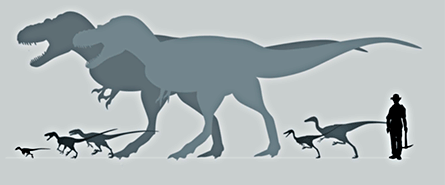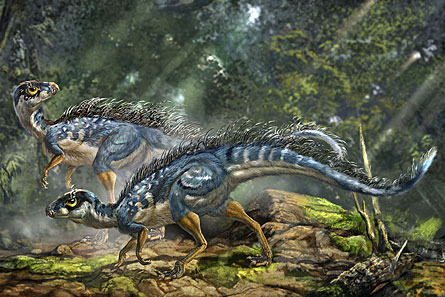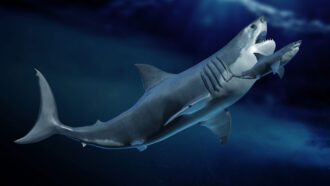Meet the new dinos
Fossil finds reveal a tiny, meat-eating species and another with featherlike features
 |
|
Tiny Hesperonychus elizabethae (far left), North America’s smallest meat-eating dinosaur, probably weighed no more than a chicken and was smaller than many of its contemporary relatives (human shown for scale). |
| Longrich and Currie |
The last dinosaurs died about 65 million years ago, long before humans started walking around. Scientists can still learn new things about these ancient animals though, thanks to the fossils they left behind. Paleontologists are scientists who study dinosaurs, and recently these researchers have made some surprising discoveries.
Canadian scientists announced they had identified the smallest meat-eating dinosaur in North America. The fossilized remains of the tiny dino had been found originally in 1982 but were recently rediscovered in a museum drawer. The remains were unearthed near Dinosaur Provincial Park, a protected area in the Canadian province of Alberta. The park is a popular place for dinosaur fans and researchers alike — more than 30 dinosaur species have been identified there.
Weighing about 4.2 pounds, the diminutive dino, whose scientific name is Hesperonychus elizabethae, was the size of a chicken. The previous record holder for smallest meat-eating dinosaur in North America weighed more than 20 pounds, or more than five of the newly identified dino.
About 75 million years ago, this newest tiny dino roamed the southern part of Alberta, just north of Montana. The scientists say the dinosaur had sickle-shaped claws, and its diet probably included insects, lizards and birds. The fossils suggest that the dinosaur is related to other small raptors (another kind of dinosaur) found in China.
About the same time the Canadian paleontologists announced the chicken-sized dinosaur news, a Chinese paleontologist announced a surprising discovery about dinosaur feathers. Feathers cover all modern-day birds, and in previous studies paleontologists have identified a featherlike structure called “dinofuzz” on some dinosaur remains. Until now, however, dino feathers had been found only in theropods and their relatives, the saurichian dinosaurs. Theropods were carnivorous dinos that walked on two legs; saurichians are also known as “lizard-hipped” dinosaurs.
Hai-Lu You, a paleontologist at the Chinese Academy of Geological Sciences in Beijing, recently described featherlike structures on a new kind of dinosaur. The species, Tianyulong confuciusi, lived between 120 and 130 million years ago. Unlike other feathered dinosaurs, however, this species was not a theropod. It was an ornithischian, or bird-hipped, dinosaur.
 |
|
This illustration shows Tianyulong confuciusi, an ornithischian dinosaur with featherlike structures. It lived in what is now northeastern China between 120 million and 130 million years ago. |
| L.-D. Xing |
The fact that You found featherlike fossils on a bird-hipped dinosaur was a big deal. It means that feathers may have evolved, or developed over a long period of time, from structures on an ancestor of both saurichian and ornithischian dinosaurs. This ancestral creature would have lived about 220 million years ago.
“This is a surprise,” says Lawrence Witmer, a paleontologist at Ohio University in Athens. “Finding a Chinese dinosaur with feathers is not remarkable, but finding one on the wrong side of the dinosaur family tree is.”
On the other hand, the fossil remains may show that many different species of dinosaurs developed feathers. It’s too early to tell. So far, only one fossil of the new species has been unearthed. As more remains come to light, they may show that the featherlike structures in the fossil are something other than feathers.
Power words: (from Britannica online)
fossil: a remnant or trace of an organism of a past geologic age, such as a skeleton or leaf imprint, embedded and preserved in Earth’s crust
ornithischian dinosaurs: One of the two major groups of dinosaurs, the other being the saurischians. Ornithischian hip bones were arranged like those of birds. Despite this similarity, ornithischians are not related to birds.
saurichian dinosaurs: The other major group of dinosaurs; it includes all birds. These dinos have hip bones arranged like those of typical reptiles.
Going Deeper:







